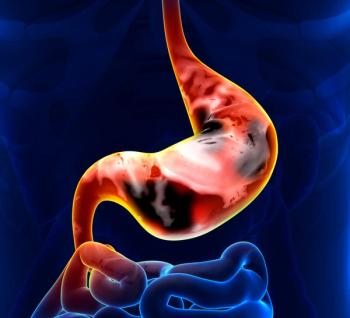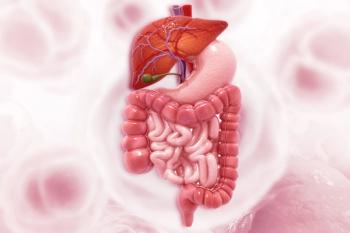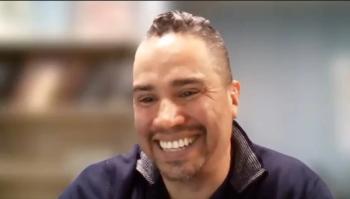
Oncology NEWS International
- Oncology NEWS International Vol 16 No 2
- Volume 16
- Issue 2
S-1, New Fluoropyrimidine, Increases Stomach Ca Survival
In patients with stage II/III stomach cancer, postsurgical administration of S-1, an experimental chemotherapy agent, improves overall survival, compared with surgery alone
ORLANDO-In patients with stage II/III stomach cancer, postsurgical administration of S-1, an experimental chemotherapy agent, improves overall survival, compared with surgery alone, according to a phase III trial from Japan presented at the 2007 Gastrointestinal Cancers Symposium (abstract 8). The adjuvant treatment is feasible and effective, and can be considered the standard treatment for stage II and III gastric cancer after curative D2 dissection, said Mitsuru Sasako, MD, PhD, professor of surgery and deputy director of the National Cancer Center Hospital, Tokyo.
S-1 is a novel oral fluoropyrimidine developed by Taiho Pharmaceutical Co., Tokyo. It combines three agents: tegafur, a prodrug of fluorouracil (5-FU); gimeracil, which inhibits dihydropyrimidine dehydrogenase (DPD) enzyme activity; and oteracil (potassium oxonate), which helps prevent gastrointestinal (GI) side effects by inhibiting phosphorylation of 5-FU in the GI tract.
In phase II trials, S-1 demonstrated a high level of activity as a single agent for metastatic gastric cancer. In the phase III trial, known as ACTS-GC, 1,059 middle-stage gastric cancer patients who had potentially curative D2 dissection were randomized to receive S-1 chemotherapy (80 to 120 mg/d, according to body surface area, for 4 weeks, followed by 2 weeks off, for 1 year) starting within 45 days after their operation or to undergo surgery alone, the current standard treatment in Japan. Study patients were enrolled at 109 Japanese institutions.
At 3 years' follow-up, the overall survival rate for all patients who received S-1 was 80.5%, compared with 70.1% for patients who received surgery alone, a 32% reduction in relative risk of death (HR 0.68, P = .0024), Dr. Sasako reported at a press briefing. For eligible patients (n = 1,034), overall survival was 81.1% for S-1 vs 70.1% for surgery alone (P = .0015). Three-year relapse-free survival was 72.2% with S-1 vs 60.1% for surgery alone (P = .0001). Recurrences were decreased with S-1 at all sites, but mainly in the lymph nodes (8.7% with surgery alone vs 5.1% with S-1) and peritoneum (15.8% vs 11.2%, respectively).
S-1 was effective across all subsets analyzed, including sex, age, disease stage, staging system (Japanese or TNM), and histological type, Dr. Sasako said.
Grade 3-4 toxicities were rare with S-1. The most common were anorexia (6%), nausea (3.7%), and diarrhea (3.1%). Dr. Sasako reported that 65.8% of the patients randomized to S-1 were able to complete their therapy.
"This is the first phase III study to compare S-1 chemotherapy following surgery to surgery alone," Dr. Sasako commented. "The findings are significant because they showed improved survival with a single chemotherapy agent-one that is cheaper and has lower toxicity than adjuvant chemotherapy regimens commonly used in North America and Europe." Dr. Sasako concluded that "single-agent S-1 can be considered as the standard treatment for stage II/III gastric cancer patients after potentially curative D2 dissection."
A. William Blackstock, MD, associate professor of radiation oncology at Wake Forest University Baptist Medical Center, Winston-Salem, North Carolina, who moderated the press briefing, agreed. "S-1 isn't being used in the United States, but phase I studies will be starting soon in this country," he said. "There is a lot of interest in this agent because of its efficacy in Asian trials. This is potentially significant because S-1 is less expensive and less toxic when compared to adjuvant therapies administered in the United States and Europe."
Articles in this issue
almost 19 years ago
Exemestane After 5 Years of Tamoxifen Prevents Relapsesalmost 19 years ago
BreastCancerTrials.org Empowers Patients to Find Trialsalmost 19 years ago
Aranesp Ineffective in Anemic Ca Patients Not on Chemoalmost 19 years ago
Rituximab/CHOP Significantly Improves Outcomes in Advanced FLalmost 19 years ago
Embryonic Stem Cell Vaccines Effective in Micealmost 19 years ago
Fewer Cancer Deaths 'No Fluke'almost 19 years ago
Higher Deferasirox Dose Helps Those With Insufficient ResponseNewsletter
Stay up to date on recent advances in the multidisciplinary approach to cancer.


















































































